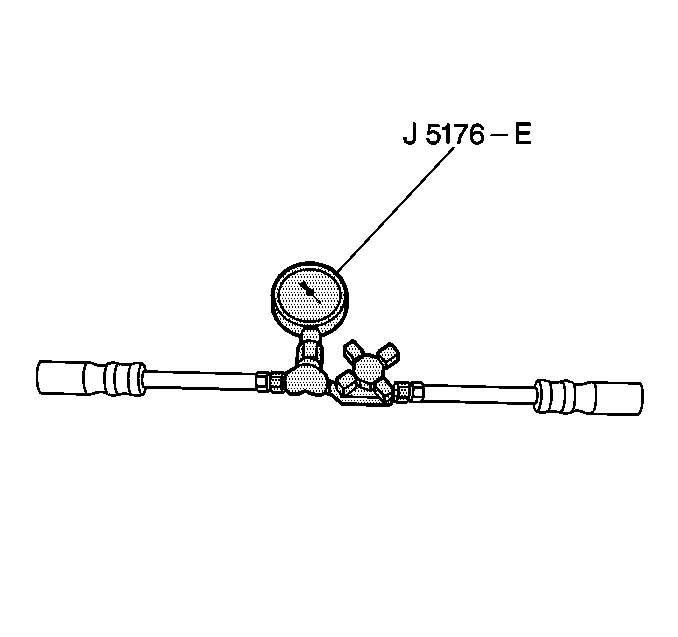Tools Required
| • | J 5176-E Power
Steering Pressure Tester |
Perform the power steering test using the J 5176-E
. Use the power steering system test in order to identify
and isolate the hydraulic circuit difficulties. Prior to performing the power
steering test, complete the following steps:
- Inspect the pump reservoir for the proper fluid level.
- Inspect the pump belt for the proper tension.
- Inspect the tires for the correct air pressure.
- Inspect the power steering system.
- Replace the power steering system parts, if needed.
Important: Perform all of the tests with the engine idling at the normal operating
temperature.
System Test with J 5176-E
Tools Required
| • | J 5176-E Power
Steering Pressure Tester |

- With the engine OFF, disconnect
the pressure hose at the steering gear or the power steering pump.
- Place a container under the steering gear or the pump in order
to catch the fluid when disconnecting or connecting the hoses.
- Install the J 5176-E
to both hoses.
- Ensure that the gauge is between the shutoff valve and the pump.
- Open the shutoff valve.
- Remove the filler cap from the pump reservoir.
- Inspect the fluid level.
- Fill the pump reservoir with power steering fluid to the full
mark on the indicator.
Important: Do not hold the steering wheel in the full turn position longer than
5 seconds, as damage to the steering pump may result.
- Start the engine.
Momentarily hold the steering wheel against the stop.
- Inspect the connections at the hoses for any leaks.
- Bleed the system. Refer to
Power Steering System Bleeding
.
- Insert a J 5421-02
in
the reservoir filler opening.
Important: In order to prevent wearing flat spots in the tires, do not turn the
steering wheel more than 5 times without moving the vehicle. Move the vehicle
in order to change the tire-to-floor contact area.
- Move the steering wheel from stop to stop until the thermometer indicates
a temperature of 65-77°C (150-170°F) in the hydraulic
fluid in the reservoir.
- Inspect the pump fluid level.
- Add power steering fluid, if needed.
- Read the J 5176-E, note the initial pressure reading on
the gauge with the valve open.
The normal pressure is 550-860 kPa (80-125 psi).
- If the pressure exceeds 1 380 kPa (200 psi),
inspect the system for the following possible conditions:
| • | Restrictions in the hoses |
| • | Improper assembly of the poppet valve. |
Notice: Do not leave the valve fully closed for more than 5 seconds, or the
pump could be damaged internally.
- Fully open and close the gauge valve 3 times.
Record the highest pressures attained each time.
- Determine whether the following conditions are present:
| • | The recorded pressures are within 345 kPa (50 psi)
of the specifications. |
| • | The pump functions normally. |
| • | The recorded pressures are high, but each reading repeats the
same pressures within 345 kPa (50 psi) of the specifications
at the end of this section. |
| • | The pump functions within the specifications. |
| • | The recorded pressures are high, but each reading does not repeat
the same pressures within 345 kPa (50 psi). The flow control
valve is sticking. |
| • | In order to repair the sticking flow control valve, complete the following
steps: |
| 3. | Use a crocus cloth or a fine hone in order to remove any burrs. |
| 4. | Flush any dirt from the system, if needed. |
| 5. | If the system is especially dirty, Disassemble the steering gear
and the pump. |
| 6. | Clean the steering gear and the pump. |
| 7. | Flush the steering gear and the pump. |
| 8. | Reassemble the steering gear and the pump. |
| 9. | Flush the system and the reservoir. |
| • | The recorded power steering pressures are constant, but the pressures
are below 690 kPa (100 psi) of the minimum specifications. |
| • | Complete the following steps: |
| 1. | Replace the flow control valve. |
| 2. | Perform the system test again. |
| 3. | If the pressures remain low, replace the rotating group. |
- If the pump pressures are within the specifications, leave the
valve open.
- Turn the steering wheel to both stops.
- Record the highest pressures.
- If the maximum pump pressure is not present, disassemble the leaking
gear.
- Turn the ignition switch to the OFF position.
- Remove the testing gauge.
- Reconnect the pressure hose.
- Verify that the fluid level is full.
- Repair any components, if needed.
- If the condition remains, verify that the steering and front suspension
are functional.

